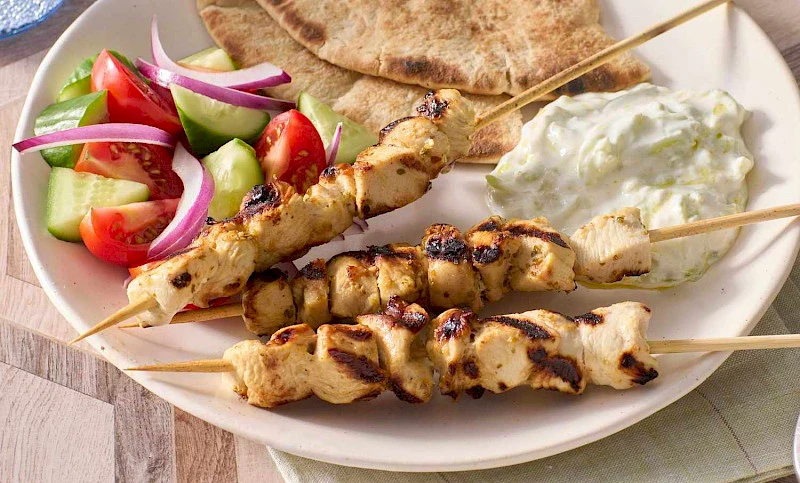Souvlaki: Traditional Cypriot Fast Food
You have probably heard of, seen, or even tried this traditional Cypriot dish. If not — it’s time to change that!

What is Souvlaki
Souvlaki is a Greek fast food consisting of small pieces of meat and vegetables grilled on a skewer. It is typically eaten straight from the skewer while still hot. It can also be served with pita or inside it, usually accompanied by lemon, sauces, vegetables like chopped tomatoes and onions, and fries as a side dish.
In Cyprus, as in Greece, pork is commonly used, but lamb is also popular. In some regions, chicken is used instead of pork.
The word souvlaki is considered a diminutive of the medieval Greek word souvla (meaning “skewer”), which in turn is borrowed from the Latin word subula.
However, in Cyprus, souvla refers to larger chunks of meat cooked on metal skewers, similar to kebabs but often with the bone intact. Souvlaki, on the other hand, consists of smaller pieces, usually cooked on wooden sticks.
History
This dish is both ancient and modern.
In Greek culture, the practice of cooking food on spits or skewers dates back to the Bronze Age, as evidenced by numerous archaeological finds and literary sources:
- Stone cooking stands with grooves for skewers on Santorini;
- Souvlaki trays from Mycenaean Greece;
- References to pieces of meat roasted on spits in Homer’s “Iliad”;
- Similar descriptions by Aristophanes, Xenophon, and Aristotle.
Modern souvlaki was described by French traveler Gustave Flaubert, who observed Greeks grilling pieces of meat on bamboo sticks during his visit to southern Central Greece in 1850.
However, the widespread popularity of modern souvlaki came much later—after World War II. Souvlaki skewers served as fast food became widely available in the 1960s.
Variations of Souvlaki
Kalamaki
Kalamaki is synonymous with souvlaki in Athens, where the word "souvlaki" is used colloquially for any type of wrap made with pita bread. Kalamaki can also be accompanied by vegetables like tomatoes, peppers, and onions, along with sauce and lemon wedges.
In Greece, there are regions where kalamaki has no connection to souvlaki, such as Thessaloniki; in these areas, souvlaki refers to what Athenians call kalamaki.
Souvlaki Merida
Merida translates from Greek as “portion.” While souvlaki is often eaten as fast food, it can also be served as a full meal, accompanied by fries, vegetables, sauce, and pita quarters. It typically includes chopped tomatoes and onions, as well as tzatziki sauce, arranged on a plate.
Souvlaki in Pita
Souvlaki pita consists of grilled souvlaki meat wrapped in slightly toasted pita bread along with chopped tomatoes, onions, tzatziki sauce, and fries as a side. Recently, it’s increasingly served inside folded pita bread, essentially making it similar to gyros.
Souvlaki in Cyprus
In Cyprus, souvlaki can refer to both small pieces of meat on skewers and the dish itself. For its preparation, large pita bread with a pocket is used. Meat (traditionally lamb or pork, though chicken is also becoming common) is cut into slightly larger pieces for Cypriot souvlaki. Tomatoes, cucumbers, and shredded white cabbage are common salad additions.
Recently, the main dish called souvlaki may also include sheftalia, though this is a separate art of meat preparation, which you can read about in our article on the Cypriot delicacy.
Frequently Asked Questions about Cyprus Cuisine
What are the famous cheeses in Cyprus?
The first one that comes to mind is halloumi—everyone knows about it. But it has a competitor that is gradually gaining popularity: Anari cheese. Here’s our article about it.
What is meze in Cyprus?
It’s a traditional serving of numerous small appetizers before the main course. Here’s what they consist of and how to enjoy them.
What alcohol should you try in Cyprus?
There are two types of traditional Cypriot alcohol, both made from grapes. However, they are produced differently and have nothing in common except the raw material. These are the famous Commandaria wine and the strong alcoholic drink zivania.
Follow us on Instagram and Telegram—we share a lot of interesting facts about Cyprus traditions and local dishes!
